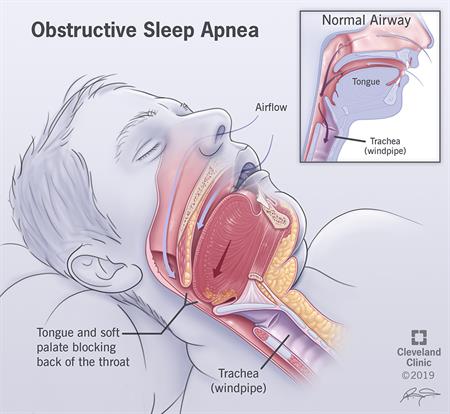 ATC
ATC
Sleep apnea is a serious sleep disorder that occurs when a person's breathing is interrupted during sleep. People with untreated sleep apnea stop breathing repeatedly during their sleep, sometimes hundreds of times. This means the brain -- and the rest of the body -- may not get enough oxygen.
There are two types of sleep apnea:
-
Obstructive sleep apnea (OSA): The more common of the two forms of apnea, it is caused by a blockage of the airway, usually when the soft tissue in the back of the throat collapses during sleep.
-
Central sleep apnea: Unlike OSA, the airway is not blocked, but the brain fails to signal the muscles to breathe, due to instability in the respiratory control center.

Am I at Risk for Sleep Apnea?
Sleep apnea can affect anyone at any age, even children. Risk factors for sleep apnea include:
-
Being male
-
Being overweight
-
Being over age 40
-
Having a large neck size (17 inches or greater in men and 16 inches or greater in women)
-
Having large tonsils, a large tongue, or a small jaw bone
-
Having a family history of sleep apnea
-
Nasal obstruction due to a deviated septum, allergies, or sinus problems
What Are the Effects of Sleep Apnea?
If left untreated, sleep apnea can increase the risk of health problems, including:
-
High blood pressure
-
Stroke
-
Heart failure, irregular heartbeats, and heart attacks
-
Diabetes
-
Depression
-
Worsening of ADHD
-
Headaches
In addition, untreated sleep apnea may be responsible for poor performance in everyday activities, such as at work and school, motor vehicle crashes, and academic underachievement in children and adolescents.
Sleep Apnea Treatments
Sleep apnea treatments range from lifestyle changes, such as losing weight or changing sleep positions, to CPAP therapy, to surgery.
Treating Sleep Apnea at Home
You may be able to treat mild cases of sleep apnea by changing your behavior, for example:
-
Losing weight
-
Avoiding alcohol and sleeping pills.
-
Changing sleep positions to improve breathing.
-
Stopping smoking. Smoking can increase the swelling in the upper airway, which may worsen both snoring and apnea.
-
Avoiding sleeping on your back.
How to Keep a Symptom Diary for Multiple Sclerosis
Multiple sclerosis (MS) symptoms come and go. One day you're fine, but the next you may be too tired to get out of bed. Lots of things can affect the way you feel, from the weather
Continuous Positive Airway Pressure (CPAP)
Continuous positive airway pressure -- also called CPAP -- is a treatment in which a mask is worn over the nose and/or mouth while you sleep. The mask is hooked up to a machine that delivers a continuous flow of air into the nose. This air flow helps keep the airways open so that breathing is regular. CPAP is the most common treatment for sleep apnea. There's also bi-level positive airway pressure, or BPAP, which is similar to CPAP but the air flow changes when you breathe in and then breathe out.
Sleep Apnea and Dental Devices
Dental devices can be made that help keep the airway open during sleep. Such devices can be specifically designed by dentists with special expertise in treating sleep apnea.
Surgery for Sleep Apnea
If you have a deviated nasal septum, enlarged tonsils, or a small lower jaw with an overbite causing the throat to be too narrow, surgery may be needed to correct sleep apnea.
The most commonly performed types of surgery for sleep apnea include:
-
Nasal surgery: Correction of nasal problems such as a deviated septum.
-
Uvulo palate pharyngoplasty (UPPP): A procedure that removes soft tissue on the back of the throat and palate, increasing the width of the airway at the opening of throat.
-
Mandibular maxillomandibular advancement surgery: Surgery to correct certain facial problems or throat obstructions that contribute to sleep apnea.
Other Treatment Options for Sleep Apnea
There are minimally invasive office procedures that reduce and stiffen the soft tissue of the soft palate. While these procedures have been effective in treating snoring, their effectiveness in treating sleep apnea in the long term isn't known.
For people unable to use a CPAP, an implanted device called Inspire is now available. The device, called an upper airway stimulator, consists of a small pulse generator placed under the skin in the upper chest. A wire leading to the lung detects the person's natural breathing pattern. Another wire, leading up to the neck, delivers mild stimulation to nerves that control airway muscles, keeping them open. A doctor can program the device from an external remote. Also, those who have Inspire use a remote to turn it on before bed and turn off upon waking in the morning.
The excess sleepiness that is often associated with sleep apnea can be treated with a medication. Soloriamfetol (Sunosi) has proven effective in improving the patient’s ability to stay awake.
